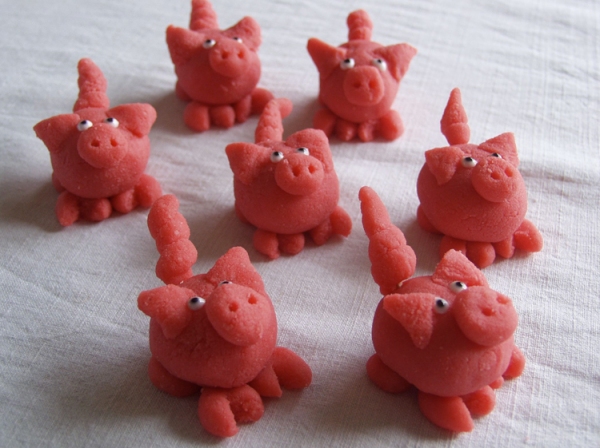When it comes to pigs, there is no beating around the bush: as much as I want to dispel the idea that German food is nothing but pork and sausage, I must acknowledge that there indeed is a longstanding and intimate relationship between Germans and their pigs.
With a per capita amount of 87 pounds per year, pork is the most consumed meat in Germany. Consumption is decreasing slightly every year, and the meat industry has a nervous eye on this development. But let’s be realistic: Germans won’t turn into a nation of vegetarians. Poultry, beef, fish and seafood have a long way to go to catch up with pork – even with their numbers added up, their overall consumption is less than pork. That Germans keep filling their plates with pork is of vital economic interest, as Germany produces more pork than it consumes. The country is the biggest exporter of pork in the European Union.
The New Year will bring some changes in pig welfare. On January 1, 2013, EU Council Directive 2008/120/EC, laying down minimum standards for the protection of pigs, will become effective for all pig holdings; up to this date it applied only to newly built or re-built premises. I love the wording of the Directive. It says, “Pigs should benefit from an environment corresponding to their needs for exercise and investigatory behavior”, and “Sows prefer to have social interactions with other pigs when provided with freedom of movement and environmental complexity.” From now on, every sow must have a little bit more space depending on its live weight. Animal rights groups say it is too little, but I think everything is too little if you compare it to the way pigs were allowed to roam freely in German woods since Roman times, feeding on acorns and beechnuts (I can only imagine how that meat must have tasted!). The value of a forest was often measured in terms of the number of pigs that could feed in it. For hygiene reasons, raising pigs has been gradually more and more constrained since the Middle Ages, eventually leading to the 0.65 square meters to which the average 94-kg sow is entitled today.
Pigs in Germany symbolize luck and good fortune, which is reflected in common expressions for lucking out (“Schwein haben”, “Schweineglück”). The origin of these idioms is believed to go back to the Middle Ages when the loser in a competition received a pig as a consolation prize.
As symbols of good luck, marzipan pigs, often with a clover leaf in their mouth, are sold for New Year’s in Germany. German settlers brought the idea of the fortune pig to America. Where I live in Pennsylvania Dutch Country, pork and sauerkraut is a traditional New Year’s dish.
Here are my marzipan piglets for New Year’s. Making marzipan is easy, I have made the recipe from my cookbook countless times, but I was quite nervous about producing a pig that truly looked like one, as I have zero experience in intricate cake decorating. Luckily I found a great short video (don’t be deterred by the German title, the video is silent and self-explanatory).
By the last piglet, I got the hang of it. So we are having a pig for New Year’s after all.
Marzipan Piglets
2 cups shelled and blanched almonds
2⅓ cups confectioners’ sugar
1 tablespoon rose flower water
Red food coloring
Vegetable oil
White and black cake decorating gel
Toothpicks
1. Grind the almonds in the food processor to a very fine powder. Add the confectioners’ sugar and the rose flower water, a teaspoon at a time. Keep grinding until a thick, smooth paste forms. Add drops of water if the paste dry and crumbly but do not overdo it, otherwise your marzipan will become difficult to shape. Frequently scrape down the sides of the food processor bowl to ensure that the entire paste is smooth.
2. Add a few drops of food coloring (a few drops go a long way!). Follow the video to shape the piglets. If your hands get too sticky during shaping, wash them thoroughly with soap and cold water and barely dry them. Repeat the hand washing as needed. When cutting out a piece for the hoofs, grease your knife with a bit of vegetable oil, to make a cleaner cut. For the eyes, make small white dots with white cake decorating gel. Let them dry for a few minutes, then make a tiny black dot in the center with black cake decorating gel. Use half a toothpick for the tail.
3. Store the piglets in an airtight container, or under a cake dome, to prevent them from drying out.
Makes 8 piglets


December 31, 2012 at 4:22 pm
these are so very cute and hooray for pig welfare! eat more marzipan
December 31, 2012 at 5:50 pm
Happy New Year from Germany, Nadja!
May your cute pigs survive this night 😉
December 31, 2012 at 6:33 pm
nice piggies. greets from Germany. 😉
January 26, 2013 at 11:29 am
Thanks katty gee. They tasted good, too.
January 1, 2013 at 4:37 pm
Cute pigs, trusting they bring you good luck in this New Year! I would have had trouble eating the good luck piggies! Does that jinx their lucky properties?
December 31, 2017 at 8:56 am
Marzipan is not a taste thatninhave cultivated in my life, BUT this recipe I would eat, and maybe try. It might go well after my traditional New Year dish of savory Black eyed peas said to bring good luck. Always need a little bit more of that!